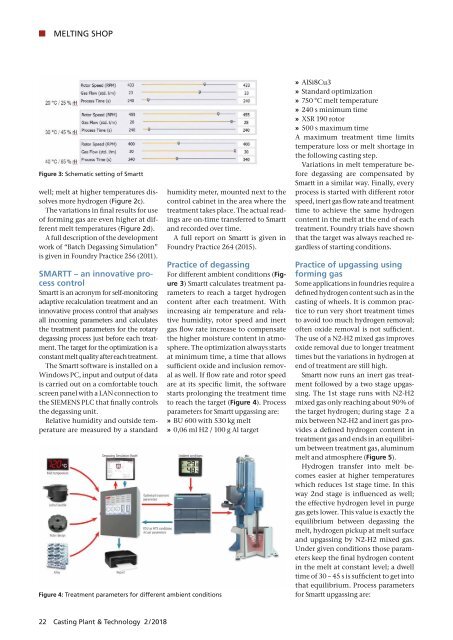CPT International 02/2018
- No tags were found...
Create successful ePaper yourself
Turn your PDF publications into a flip-book with our unique Google optimized e-Paper software.
MELTING SHOP<br />
Schematic setting of Smartt<br />
well; melt at higher temperatures dissolves<br />
more hydrogen (Figure 2c).<br />
The variations in final results for use<br />
of forming gas are even higher at different<br />
melt temperatures (Figure 2d).<br />
A full description of the development<br />
work of “Batch Degassing Simulation”<br />
is given in Foundry Practice 256 (2011).<br />
-<br />
<br />
Smartt is an acronym for self-monitoring<br />
adaptive recalculation treatment and an<br />
innovative process control that analyses<br />
all incoming parameters and calculates<br />
the treatment parameters for the rotary<br />
degassing process just before each treatment.<br />
The target for the optimization is a<br />
constant melt quality after each treatment.<br />
The Smartt software is installed on a<br />
Windows PC, input and output of data<br />
is carried out on a comfortable touch<br />
screen panel with a LAN connection to<br />
the SIEMENS PLC that finally controls<br />
the degassing unit.<br />
Relative humidity and outside temperature<br />
are measured by a standard<br />
Treatment parameters for different ambient conditions<br />
humidity meter, mounted next to the<br />
control cabinet in the area where the<br />
treatment takes place. The actual readings<br />
are on-time transferred to Smartt<br />
and recorded over time.<br />
A full report on Smartt is given in<br />
Foundry Practice 264 (2015).<br />
<br />
For different ambient conditions (-<br />
) Smartt calculates treatment parameters<br />
to reach a target hydrogen<br />
content after each treatment. With<br />
increasing air temperature and relative<br />
humidity, rotor speed and inert<br />
gas flow rate increase to compensate<br />
the higher moisture content in atmosphere.<br />
The optimization always starts<br />
at minimum time, a time that allows<br />
sufficient oxide and inclusion removal<br />
as well. If flow rate and rotor speed<br />
are at its specific limit, the software<br />
starts prolonging the treatment time<br />
to reach the target (). Process<br />
parameters for Smartt upgassing are:<br />
» BU 600 with 530 kg melt<br />
» 0,06 ml H2 / 100 g Al target<br />
» AlSi8Cu3<br />
» Standard optimization<br />
» 750 °C melt temperature<br />
» 240 s minimum time<br />
» XSR 190 rotor<br />
» 500 s maximum time<br />
A maximum treatment time limits<br />
temperature loss or melt shortage in<br />
the following casting step.<br />
Variations in melt temperature before<br />
degassing are compensated by<br />
Smartt in a similar way. Finally, every<br />
process is started with different rotor<br />
speed, inert gas flow rate and treatment<br />
time to achieve the same hydrogen<br />
content in the melt at the end of each<br />
treatment. Foundry trials have shown<br />
that the target was always reached regardless<br />
of starting conditions.<br />
<br />
<br />
Some applications in foundries require a<br />
defined hydrogen content such as in the<br />
casting of wheels. It is common practice<br />
to run very short treatment times<br />
to avoid too much hydrogen removal;<br />
often oxide removal is not sufficient.<br />
The use of a N2-H2 mixed gas improves<br />
oxide removal due to longer treatment<br />
times but the variations in hydrogen at<br />
end of treatment are still high.<br />
Smartt now runs an inert gas treatment<br />
followed by a two stage upgassing.<br />
The 1st stage runs with N2-H2<br />
mixed gas only reaching about 90 % of<br />
the target hydrogen; during stage 2 a<br />
mix between N2-H2 and inert gas provides<br />
a defined hydrogen content in<br />
treatment gas and ends in an equilibrium<br />
between treatment gas, aluminum<br />
melt and atmosphere ().<br />
Hydrogen transfer into melt becomes<br />
easier at higher temperatures<br />
which reduces 1st stage time. In this<br />
way 2nd stage is influenced as well;<br />
the effective hydrogen level in purge<br />
gas gets lower. This value is exactly the<br />
equilibrium between degassing the<br />
melt, hydrogen pickup at melt surface<br />
and upgassing by N2-H2 mixed gas.<br />
Under given conditions those parameters<br />
keep the final hydrogen content<br />
in the melt at constant level; a dwell<br />
time of 30 – 45 s is sufficient to get into<br />
that equilibrium. Process parameters<br />
for Smartt upgassing are:<br />
22 Casting Plant & Technology 2 / <strong>2018</strong>


















